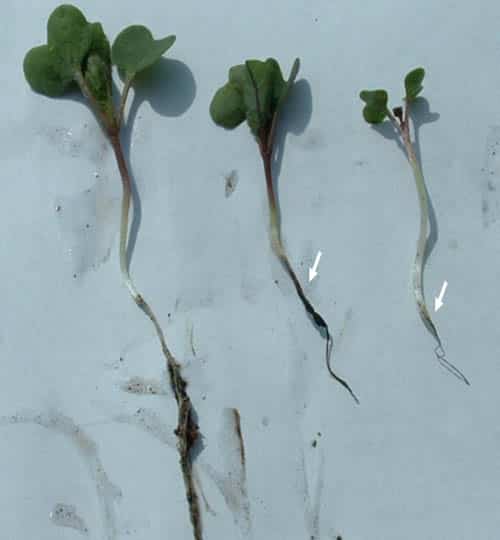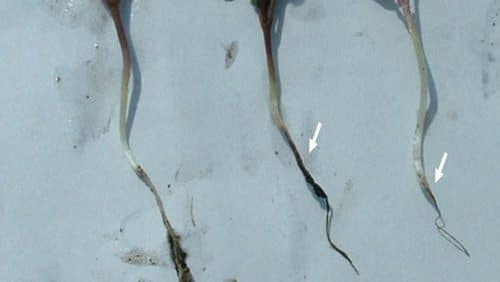
The seedling diseases risk increases with moist soil conditions and with tight canola rotations. The three best management steps for canola in this situation are:
1. Use treated seed. Certified seed all comes treated, but if you’re tempted to use non-treated seed as a bulking agent, don’t bother. Seeds and seedlings from this seed will become hosts for disease and make the disease risk worse.
2. Seed shallow. Canola seeded shallow will emerge faster, and reach the safe 4-leaf stage that much faster. Shallow seeded canola also has a shorter seed stem, and thus a smaller area of exposure to these pathogens.
3. Don’t cheat on the seeding rate, especially if seedling diseases have been a problem in past years. Make allowances for significant mortality.
The primary seedling disease pathogens in canola are fusarium, rhizoctonia, and pythium. They are not host specific, which means the same species can infect a wide range of plants — not just canola. Rhizoctonia AG-2 race is most common in canola and AG-4 is most common in peas, but each has virulence in the other crop, so rotation of canola and peas may not have a benefit as a disease management tool. But before you think that canola on canola is therefore OK, consider pythium. With pythium, canola on canola can make the situation worse because you are reducing the variance within the pathogen — selecting for races that are most virulent to canola.
Scout early: Disease damaged canola seed and seedlings are hard to spot, and they can dry up and disappear quickly because they’re so small. Start field scouting 10 to 14 days after seeding. Examine non-emerged areas, digging down to study the state of the seed and looking for dying or dead seedlings. Look for seed decay, pre- and post-emergence damping-off (wirestem), seedling blight and seedling root rot.
In general, seed and seedling losses from these diseases tend to be highest under cold wet conditions or when the seedbed is not firmly packed under dry, cool conditions. More specifically, cold damp soils favor pythium species. Loose, cold, dry and well-worked soils favor rhizoctonia. Wet, heavy soils favor fusarium.

